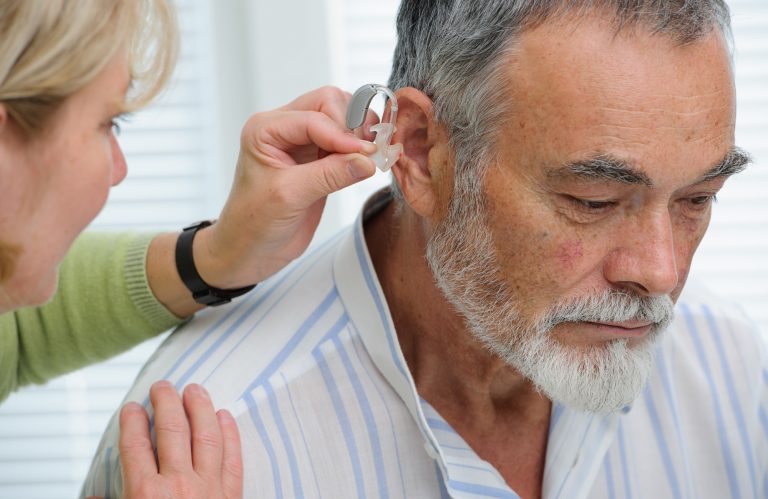The magic of hearing is something that can be taken for granted. One in six Australians are hearing impaired, suffer from deafness or have an ear disorder that impacts on hearing. If you are having trouble hearing in large groups or noisy situations, you may be one of these people.
Hearing aids are one way to restore hearing to a level that can allow you to enjoy life. But those who wear hearing aids should understand that ear wax build-up can be a common side effect of wearing hearing aids. This excess ear wax may require regular manual removal. Take a look at our guide below on earwax and hearing aids for more information.

Why Can Hearing Aids Cause Excess Ear Wax?
For most people, the ears are self-cleaning. They clean themselves through a process in which the movement of the jaw moves ear wax from the outer third of the ear canal to the entrance of the ear, where it naturally falls out. This natural process means that wax normally makes its way out of the ears without any assistance.
Hearing aids can disrupt this process. Hearing aid domes placed in the ears day after day can push wax down the canal, instead of the wax moving out naturally. This disruption can also be impacted by cotton bud use. This can lead to wax building up within the canal and eventually it can become impacted. At this point, manual removal is often required.
Hearing aids typically sit in the ear for all waking hours. That means, there is a block in the natural migratory process for ear wax, which is why build-up is common. When you get your hearing aids fitted, ear wax removal is often recommended.
Effects Of Ear Wax On Hearing Aids
The acidity of ear wax coupled with the moisture of perspiration can damage the electronics of hearing aids. In fact, it is one of the leading causes of premature failure and the return of hearing aids to the manufacturer for repairs. Hearing aids are delicate and expensive pieces of equipment so repairs and replacements can be costly. Ensuring your ‘wax guards’ are changed when needed and having wax removed regularly through microsuction can assist in preventing these problems.
A build-up of earwax can also impact on hearing aid performance. If you imagine the hearing aid speaker delivering sound down the ear canal, only to hit a large wall of wax, you can see where problems arise. The sound cannot reach the eardrum and will instead be delivered back to the hearing aid microphone, leading to a whistling and squealing noise. This hearing aid ‘feedback’ can be alleviated through wax being removed.
To counteract the above problems, your hearing aids will be fitted with a wax guard, but you need to monitor this guard. Always follow the instructions given by your hearing aid supplier about how to both clean and dry your aids and change your wax guards.
The Importance of Looking After Your Hearing Aids
To care for your hearing aids, you should change your wax trap at least once every three months or whenever the hearing aid isn’t working*.
You should also regularly clean your hearing aid moulds. If directed by your hearing aid provider, once the ear-mould is detached, soak it in a mild soapy solution; do not use isopropyl alcohol, solvents, or oils to clean earmolds* unless part of your specific hearing care plan. You could also try cleaning the mould with the brush supplied from your cleaning kit – try doing this in the morning as the wax may be drier and easier to remove.
Again, ensuring you follow the advice of your hearing aid supplier is key and they will be happy to help you learn how to care for your hearing devices.
Removing Ear Wax From Your Ears
In addition to keeping your hearing aids free of wax, you also need to keep your ears free of wax. The guidelines* recommend a wax check by your health professional every 3-6 months in order to monitor the wax. If wax build up is identified and wax removal is recommended, visit your local award-winning Earworx clinic which uses Earworx’s micro-suction process.
This procedure is carried out by our highly trained Registered Nurses. The nurse uses small instruments like forceps and curettes as well as micro-suction to dislodge and gently-remove wax blockages. The nurse monitors the entire process with the use of ‘loupes’, which are binocular magnified glasses fitted with a bright light.
The process of ear wax removal for hearing aid users runs as follows:
- The nurse will ask you a series of questions to learn more about your ear health history.
- The nurse will use a speculum to check the wax build up. If there is a significant impaction, the entire procedure will be explained to you in detail, and you will be given a chance to ask questions.
- Curettes, microforceps and microsuction will be used to dislodge and gently remove the wax blockage, providing often instant relief from wax related symptoms.
Appointments for Ear Wax Removal for Hearing Aid Users
You can make an appointment for ear wax removal at one of our clinics online or call 1800 327 967. Visit our clinics tab for information on clinic locations and contact details.
For more information click here to view or download the Earworx brochure.
*Schwartz et al 2017, Clinical Practice Guideline (Update): Earwax (Cerumen Impaction), Otolaryngology-Head and Neck Surgery Vol 156 (IS) SI-S29
